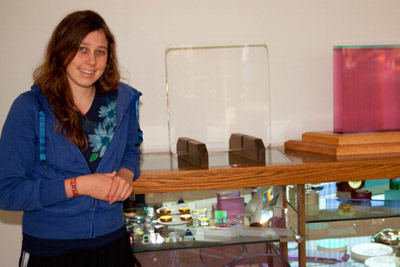Student Spotlight
Alexandra Carlson

Project Description: Develop a classification system of potential damage sites on the NIF Final Optics based on the sites’ morphology (i.e., shape, color, size, roughness of edges, etc.) and automate the classification process using a wavelet transformation algorithm, called the Image Analysis Classification (IAC), written by Wim deVries. The project includes the manual classification of sites, machine learning/training of the IAC algorithm to recognized specific morphologies, and accuracy tests of the algorithm. In the future, it is hoped the algorithm can be used to help strategically track damage sites and also be used to monitor and develop rules concerning morphology-based growth of potential damages. To learn more about this project, see Alexandra's poster.
Student Affiliation: Univeristy of Chicago (Junior, Physics)
How the NIF Summer Internship Program helped you:
I’ve learned about computer modeling and the role it plays in physics, as well as other types of research and data mining tools that will help me later on in my career. The project has been really fun – I, in a way, feel like the Sherlock Holmes or Charles Darwin of optics’ damage sites. It’s been interesting trying to figure out the way to match a site’s morphology to a specific damage type all in the context of how it would be best used in the testing and molding of the IAC algorithm.
What you can learn at NIF:
One of the main things I’ve learned is how many different ways material (the optic, the coating, contamination) can interact with the NIF laser system and the types of weird and interesting sites that can result from it. Also, I’ve found the Student Summer Series of lectures here fascinating and very career broadening, especially the seminars about LIFE (Laser Inertial Fusion Energy). I toured NIF when I was at the Cosmos Summer program at UC Davis (when I was in high school) and have wanted to work at LLNL ever since.
Student Impact:
The study of laser-induced damage in optics plays a critical role in modeling the lifetime of optics and implementing the operation strategies using models and tools such as SPLAT (Shot Planning and Analysis Tools). Understanding how the morphology of a damage site affects the growth behavior could dramatically increase the model accuracy as well as contribute to the fundamental understanding of the root causes. This capability to automatically classify numerous detections to various morphology types is integral to the success of this research.



